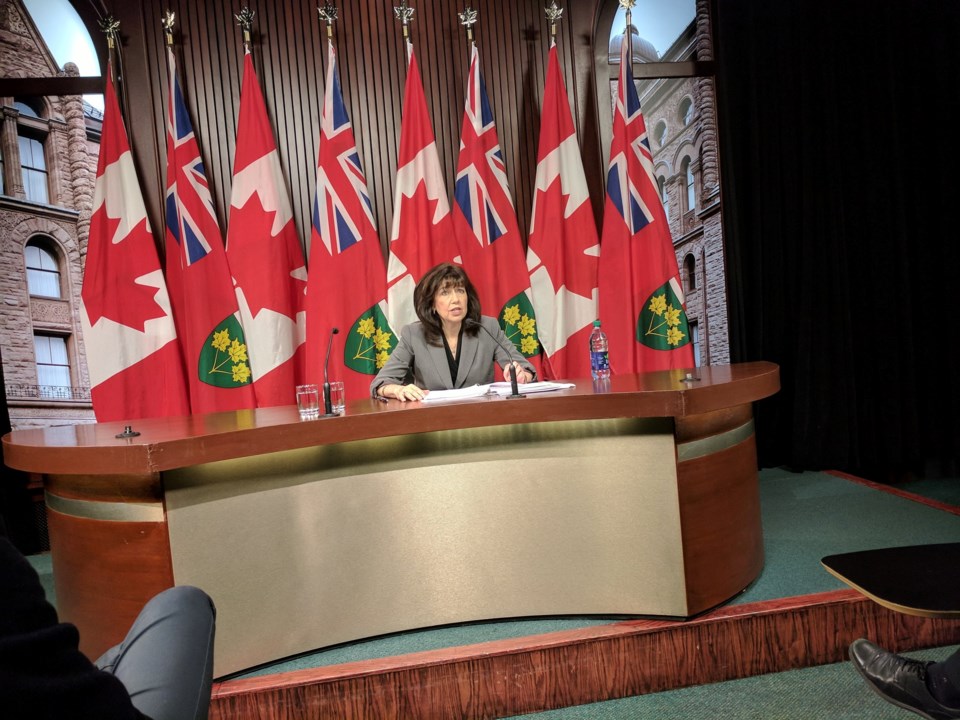Ontario's auditor general is slamming the Liberal government for a complicated accounting manoeuvre in its Fair Hydro Plan designed to make it look as though the province is balancing the books.
The problem, Bonnie Lysyk wrote in her report released Tuesday, is the accounting procedures will add an extra $4 billion in costs to the plan, on top of the almost $40 billion it will cost taxpayers by 2028.
“When governments pass legislation to make their own accounting rules that serve to obfuscate the impact of their financial decisions, their financial statements become unreliable,” Lysyk wrote in her report. “This is particularly concerning when a government states that it follows Canadian Public Sector Accounting Standards (PSAS) when in fact, the accounting rules being applied are actually not in accordance with Canadian PSAS.
“In essence, the government is making up its own accounting rules.”
The reason, the auditor wrote, was that from the beginning, the Liberals decided whatever hydro rate relief plan they came up with could not lead to the government running a deficit.
“The government set this as the mandate to the senior officials and private-sector external advisers designing the accounting and financing for the rate reduction,” she wrote.
To do this, the Liberals created something call the OPG Trust, basically a paper asset where the hydro deficit could be parked so it wouldn't show on the government's balance sheet. The government spent more than $2 million on private-sector advisers to help them craft the plan.
“When organizational structures and transactions are designed to remove transparency and accountability, and unnecessarily cost Ontarians billions of dollars, the responsibility of an auditor general is to apprise the Legislature and the public in accordance with the Auditor General’s mandate,” Lysyk wrote.
“After reviewing the information available to us, it is clear to us that the government’s intention in creating the accounting/financing design to handle the costs of the electricity rate reduction was to avoid affecting its fiscal plan. That is, the intention was to avoid showing a deficit in the province’s budgets and consolidated financial statements for 2017-18 to 2019-20, and to likewise show no increase in the provincial net debt.”
Nickel Belt MPP France Gélinas said even for this government, the auditor general's findings are shocking.
"Not only are we paying an extra $40 billion because we are deferring payments to later, but we are also paying $4 billion -- big numbers -- so that they could create this accounting thing that would not show up on the provincial budget as a deficit," Gélinas said. "Can you imagine? I have such a hard time coming to grips that a government would agree to spend that amount of money -- hydro payers money -- to not show a deficit.
"This is a new low, just because of the size of it. And I've covered some pretty low spots," she said, referring to the Ornge scandal, the gas plant scandal and the eHealth scandal. "The only purpose (the OPG Trust) serves is to not show a deficit. Really?"
In a statement, Sudbury MPP and Energy Minister Glenn Thibeault disagreed with Lysyk's conclusions.
“I thank the Office of the Auditor General for its report on Ontario’s Fair Hydro Plan,” the statement begins. “However, the government does not agree with the assertions and conclusions of the report.”
Thibeault said the province has been making huge investments in the energy grid, and while they have driven hydro rates up, they also have created a reliable and cleaner energy system.
“The Fair Hydro Plan smooths the cost of those investments out over a longer period of time,” the statement said. “This means that those benefitting from the investments we’ve made will be the ones paying for them. And that’s fair.
“The accounting practices in the Fair Hydro Plan are well-established, and well-recognized within the industry. In fact, six of eight other independent system operators – AESO in Alberta, ISO in New England, NYISO in New York, MISO in Minnesota, PJM in the Midwest and Eastern Seabord, and ERCOT in Texas – use a rate regulated accounting structure. And it’s a common practice for companies like Toronto Hydro, Hydro One, and Fortis.”
The accounting policies were designed and reviewed by senior staff from the Ministry of Energy, Ministry of Finance, Treasury Board Secretariat, Office of the Provincial Controller, Cabinet Office, the Ontario Financial Authority, the Independent Electricity System Operator, and Ontario Power Generation, the statement said.
And third-party experts from firms such as KPMG, E&Y, and Deloitte were also consulted by government and its agencies on the structure of the accounting.
“These are policy choices we made to ensure that we continue to have a clean, reliable affordable electricity system for the ratepayers of today, and the ratepayers of tomorrow. That’s exactly what the Fair Hydro Plan has done, and what it will continue to do into the future.”
Read Lysyk's full report here.
